Proof that the Zapruder film is authentic
One of the central arguments in the book
Assassination
Science is that the Zapruder film is not authentic. Various researchers
argue that frames had been cut out for some conspiratorial motive. On pages
310 to 315 Dr. Mantik discusses the strange ghostlike images in the sprocket
hole area. He does not know what caused them and suspects that they indicate
tampering. Balderdash. To date, no one has correctly explained what those
images are and how they were created. For many years I have puzzled over
them and discussed them with other researchers, but never reached a firm
conclusion due to the very poor quality of the Zapruder film versions we
have had. Now MPI has released the original Zapruder film with the sprocket
hole areas intact. Within 5 seconds of viewing this new videotape release
of the Zapruder, I knew instantly what the sprocket hole images are and
exactly what caused them. You, gentle reader, will be among the first people
to learn the truth. Since the publication of this article this summer I have
received positive feedback from Internet readers which has allowed me to
figure out what more of the ghost images are. I have revised and updated
this article from this point to reflect the new information.
The Zapruder film proves itself to be authentic.
There is no possibility that any frames could have been cut out of the
film. Every time a frame was exposed, part of the background scene was
exposed onto the next frame and the previous frame in their sprocket hole
areas. The ghostlike images in the sprocket hole area are double exposures.
Real objects faintly visible. The cause is the particular design of the
inner workings of the Bell & Howell camera. When a frame is being exposed,
there is an aperture plate which covers the frames above and below the
current frame so that they do not get accidentally exposed. Some 8 mm cameras
leave open the sprocket hole area of the current frame, which allows information
to be recorded there, but that area is normally not projected. Some 8 mm
cameras have a notch in the top of the aperture plate where the claw
finishes its stroke when pulling down the next frame. Bell & Howell
designed the aperture plate to use a groove in the middle of the aperture
plate instead of a notch at the top. The illustration on the left is from
a standard reference on film making which shows what an aperture plate
looks like with a typical notch. The illustration on the right is what
the aperture plate would look like if the notch had been changed to a groove.
I also suspect that the corners are actually rounded instead of sharp.
After exposure of the current frame, the claw grabs the current frame's
sprocket hole and pulls the current frame down to bring in the next frame.

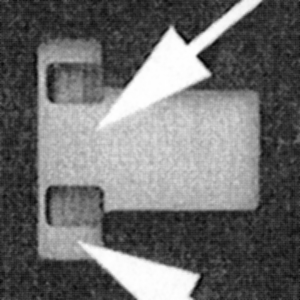 Addendum 11/22/98
Addendum 11/22/98
The picture on the right is a close-up of the aperture plate published
in the Zavada report which was released by the National Archives
on November 9, 1998.
Mr. Zavada is the premiere Kodak authority on 8 mm film. He carefully studied
the issue of the Zapruder film anomalies and found that the Zapruder film is authentic. The unique properties of the camera and the films used make it
virtually impossible for anyone to have tampered with or faked the original film.
It is very close to the upper illustration which I had composed in the computer.
There is even a rounded corner as I had suspected.
Don't misunderstand the illustration on the
upper right.
This is not actually the aperture plate from Zapruder's Bell &
Howell. This is just my impression of what it probably looks like in order
to produce the double exposures. Bell & Howell is no longer in the
8 mm camera business, so it may be difficult to get the original diagrams
and schematics. I have contacted Bell & Howell and asked them to see
if they still have manuals and diagrams for that model camera. If they
send me the original diagrams I will try to post them here in place of
the above illustration.
Paul Burke has noted that the outline of the
ghost images as derived from comparing numerous frames' ghost images reveals
more detail about the design of the aperture plate. While I am not endorsing
his illustration showing the outlines of the aperture plate as being exactly
the same shape as Zapruder's aperure plate, it may well be very close to
the reality. It would appear from Burke's interpretation that the claw
was not the full width of the sprocket holes. I have seen examples of that
type of narrower claw in films I have examined, although in my examples
the claw would grab the leftmost side of the sprocket hole and in Burke's
illustration the groove's design would mean that the claw in Zapruder's
camera grabbed the rightmost side of the sprocket hole area, creating ghost
images whose boundaries conform to the outlines of the aperture plate as
he has diagrammed it.
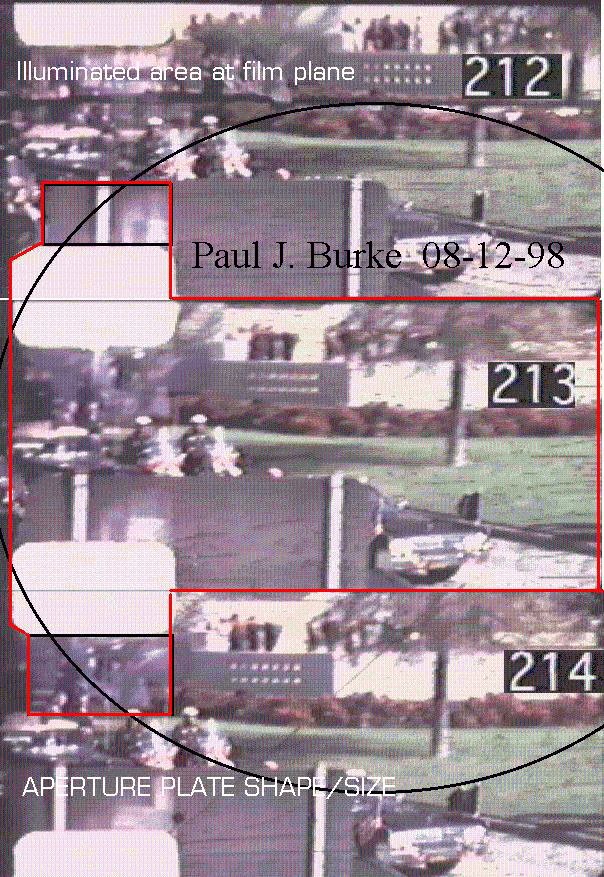
The Forces of Dark and Light
Dr. Mantik is correct that the ghostlike
images do not appear everywhere in the film consistently. But he is incorrect
that they occur in only one or two places. The double exposures are in
all sequences of the film, but not in every frame, or at least not easily
visible in every frame. Just how clearly the ghostlike images appear is
a battle between the forces of dark and light. During the exposure of the
current frame, if the area being exposed in the next frame's upper sprocket
hole area is very bright and the regular sprocket hole area of the next
frame has a background which is very dark, then the ghostlike image will
be very bright. For example, in many frames before, during. and after the
head shot at Z-313, as Dr. Mantik has pointed out, the background in the
upper sprocket hole area of the current frame is very dark, such as the
infield grass while the image from the previous frame already exposed by
the bleed around was very bright, such as Chaney's white front fender.
At the other extreme, when the information
in the current frame's upper sprocket hole area is very bright, such as
the cars behind the limousine seen in early frames, this swamps out the
much darker earlier exposed sprocket hole image, such as the dark green
grass on the north side of Elm Street or the road. A few ghostlike images
are easily visible just above the lower sprocket hole. One of the few places
where we can easily see ghostlike images just above the lower sprocket
hole is when the Stemmons Freeway sign is in the current frame's sprocket
hole area. So, what looks like ghost images projected onto the back of
the Stemmons Freeway sign are actually the windows of the Dallas County
Records building on Houston Street.When the two forces are roughly equal,
the ghostlike images are faintly visible.
I have prepared some illustrations
in the computer to help show what area would be exposed in Zapruder's camera
due to the groove in the aperture plate. Figure 1 is frame 183 which includes
the sprocket hole. Notice the ghost image in the lower sprocket hole area
just above the sprocket hole. This looks like some type of architectural
feature projected onto the dark clothing of the spectators at the curb.
In fact it is the front of one of the buildings on the north side of Elm
Street in the 500 block.
Figure 1
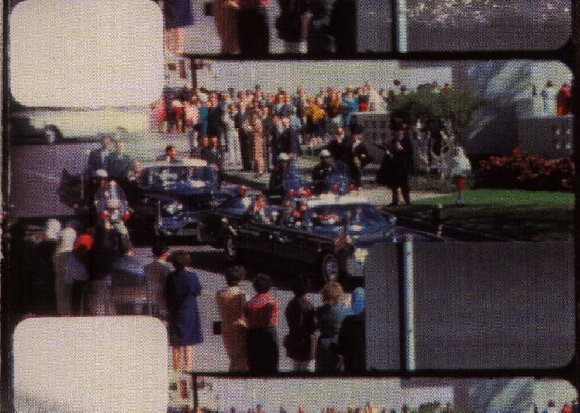
I do not currently have two consecutive frames
from the newly released Zapruder film scanned into the computer in order
to illustrate the extended tabs of exposure from one frame into the two
adjacent frames' sprocket hole areas. I could only find one color photo
taken from Zapruder's vantage point to illustrate how much area a typical
exposure plus tabs would cover. Unfortunately it was taken after 1963 and
there had been many changes to Dealey Plaza. For example, the Stemmons
Freeway sign had been removed and several streets lights were moved. The
new overhead signs get in the way of seeing the buildings farther down
Elm Street. But just above the new signs' horizontal post you can see the
windows of a building on Elm Street in the 500 block. And I have
no idea what kind of lens was used for this photo, while Zapruder's camera
was set on telephoto, so the appearance of the field of view is not the
same. Showing what area is covered by the tabs might allow careful researchers
to identify objects seen in that area in other films and photos. Figure
2 shows, approximately, the extent of the tabs of Z-183.
Figure 2
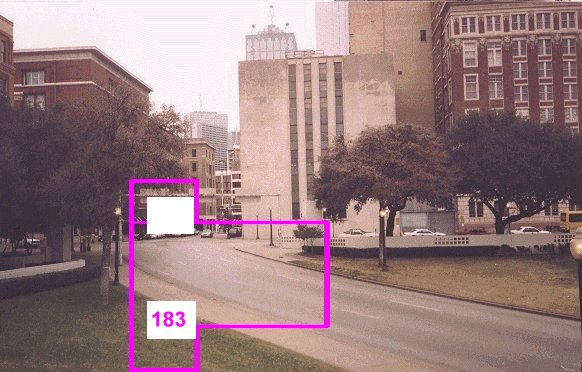
In the July 28, 1998 issue of the Globe
weekly, several frames with the sprocket holes were published. Frame 225
shows the ghost image on the back of the Stemmons Freeway sign. This ghost
image is actually the face of the Dallas County Records Building (DCRB).
Figure 3 is frame 225. Compare the ghost image to the face of the DCRB
in the Warren Commission's Exhibit No. 895 which includes a photograph
from the reenactment and shows the areas above and below the Zapruder camera
frame. Figure 4 is the reenactment photo.
Figure 3
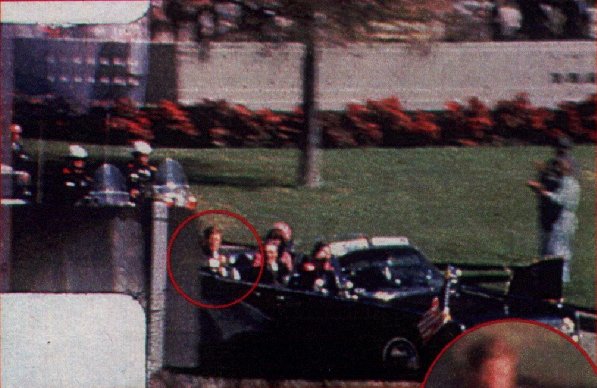
Figure 4

So far, I have only dealt with elements of
absolute proof which can be verified by physics and mechanics, and of course
by examination of Zapruder's camera. Now we have to delve into areas where
cueing can take place. Interpretation of what the ghostlike images could
be. In some cases, they are rather obvious and can be easily confirmed
by referring to other films, photos, and maps. But in some cases, I may
see someone ONLY because I expect to see someone there. I have made a list
of observations of what I think the ghost images are. When I am very sure
what it is, I will just state the object. When I am not sure, I will qualify
my observation appropriately. You are encouraged to view the newly released
Zapruder film and be cued by my list of observations to see if you agree
with me and then make your own observations.
One word of caution however. Because MPI had the film rotoscoped in
the computer to reduce the jitters, some objects will not move as expected.
They may even appear to move backwards, as Zapruder jiggled the camera
slightly. That is not an indication of doctoring the original film. It
is an indication of doctoring the digitized version to make it more presentable
to the public.
Frames 164 to 189 - building in 500 block of Elm Street in the lower
sprocket hole area.
Frames 190 to 206 - bright object in the lower sprocket hole area.
Frames 212 to 230 - face of DCRB in the lower sprocket hole area against
the back of the Stemmons Freeway sign.
Frames 255 to 264 - a north side (right lane) traffic line in the upper
sprocket hole area.
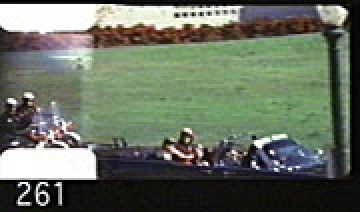
Frames 264 to 289 - wall "B" leading to North Peristyle in the lower
sprocket hole area.
Frames 302 to 309 - North Peristyle in the lower sprocket hole area.
Frames 284 to 305 - motorcycle (Chaney's?) in the upper sprocket hole
area.
Frames 308 to 332 - motorcycle (probably Chaney's) in the upper sprocket
hole area.
Z-313: Notice that the ghost image of Chaney's cycle is NOT blurred
vs. Hargis's blurred image
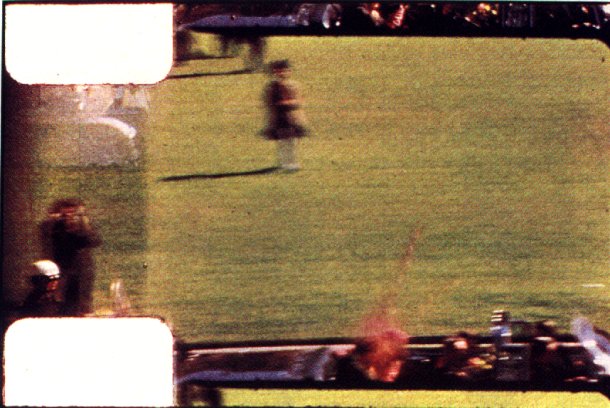
Z-334?
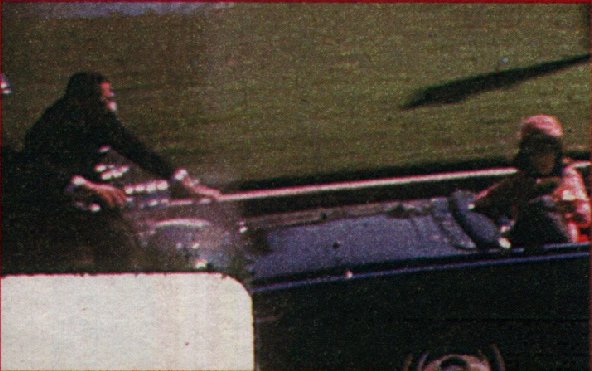
Frame 339 - a north side (right lane) traffic line in the upper sprocket
hole area.
Frame 355 - shadow on the road from limousine's right rear handhold
in the upper sprocket hole area.
Frame 418 - bushes and road in the upper sprocket hole area.
Frame 434 - branches (much like those in Z-413) in the upper sprocket
hole area.
Frame 448 - branches, grass, and sidewalk in the upper sprocket hole
area.
Frame 479 - possibly part of a road sign in the upper sprocket hole
area..
Now, what are the implications of this discovery
about the Zapruder film? For one thing, it makes it extremely unlikely
that anyone could have tampered with the film and reproduced the ghost
images perfectly. When you consider that no one else, not even the best
camera experts in the world, realized the mechanism which caused the ghostlike
images for over 34 years, it seems highly unlikely that the conspirators
would know about this characteristic of Zapruder's camera and be able to
duplicate it within a few hours. If someone were to remove a frame or two
here and there, the ghost images in the tabs would not line up properly
with the new adjacent frames and would expose the alteration. It is time
for everyone who has doubted the authenticity of the Zapruder film to realize
that the Zapruder film is genuine and authentic, and now move on with their
research.

 Addendum 11/22/98
Addendum 11/22/98







